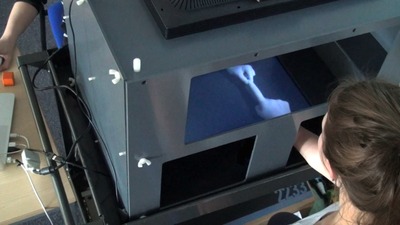Perceptual distortions of the body in pain

Adelaide researcher Dr Tasha Stanton has always been frustrated by pain. Not her own but that of others and why, with all of our scientific advances and very large brains, we can’t do more to alleviate it, especially in those who live with chronic pain.
Stanton knows a thing or two about pain. Originally trained as a physiotherapist, she has probably dealt with the intractable effects of chronic pain more than most.
Eventually, this experience led her into the field of neuroscience in a quest to understand pain. In particular, she became fascinated with how the brain perceives pain and what is different in the brain when pain persists. These days, Stanton is a postdoctoral research scientist who splits her time between the Body and Mind Centre at the University of South Australia, in Adelaide, where she now lives, and Neuroscience Research Australia in Sydney.
At the Australasian Neuroscience Society meeting in January, Stanton will present her work as part of what promises to be a fascinating session on neuroperception.
“Specifically, I will present the idea that changing how a painful body part looks or feels can actually influence pain levels. I will discuss the background of this work and why we think such a perplexing effect might be happening.”
It is all in our minds
Pain is primarily a useful tool for us mammals - it allows us to know when something is wrong and we need to act. What is important, however, is how and when pain occurs.
Threatening or damaging stimuli alert our neural system by activating specialised receptors called nociceptors, and this information is transmitted to the brain to decide whether to perceive this information as painful. This decision then sets off a whole stack of pathways to act appropriately.
However, chronic pain has gone far beyond the acute nociceptor stimulus to an ongoing interpretation by our brain that something is wrong. The pain experience, and chronic pain in particular, is modulated by a variety of factors including motor control, emotional state, visual cues, memory cues and even neuropsychological factors such as anxiety and depression - and each of these factors is known to involve different areas of the brain in terms of neural activity.
Scientists like Stanton are increasingly interested in just how these brain areas work together to heighten or diminish the pain experience.
“We just don’t have good treatments for chronic pain, despite all the excellent work that has been done, and perhaps we just don’t have the whole picture.”
Stretching the ‘truth’ could help
Professor Roger Newport from the University of Nottingham in the UK was a pioneer in the concept of illusory modification of the body to influence pain. Recently, he designed a specialised machine called the MIRAGE multi-sensory illusions box, which contains a combination of cameras, mirrors, computers and monitors to deliver a range of illusions.
Subjects insert their painful body part into the machine and can view it in real time. Then the MIRAGE machine is used to alter how the body part looks.
“For instance, someone who has painful hand osteoarthritis can view their hand ‘shrinking’ or ‘stretching’ in real time,” explained Stanton. “So visually, they see the hand changing, but then we also provide tactile input, that is, a ‘push’ or a ‘pull’ to their finger that matches the visual changes. So it actually ‘feels’ like the finger is physically altered - it is a very weird sensation.”

In 2011, Newport used his MIRAGE machine to study the effect of illusory stretching or shrinking in people with hand osteoarthritis and reported an immediate pain reduction of around 35-50% in most participants. The effect was greater with stretching in some patients and with shrinking in others, while some cases responded favourably to both illusions.
Importantly, his and other studies confirmed, with control conditions and by testing a non-painful area of the body part, that the effect of pain reduction was not simply related to distraction or attention.
On reading about Newport’s findings and machine, Stanton wondered if the same effect would come into play for patients with knee osteoarthritis and she is now collaborating closely with Newport to find out.
“Osteoarthritis of the knee affects around 2.6 million working-age Australians and, in combination with hip osteoarthritis, results in about 80,000 joint replacements every year. It causes significant pain and disability, often limiting the ability to work. So, if we could help to reduce pain or at least make it manageable in these patients, that is a huge step forward in many respects.”
Playing with reality
The background to Stanton’s work is that people with chronic pain often have altered physical self-awareness or a distorted perception of their painful body part, such as feeling that their affected limb is larger or more swollen than it actually is.
“It is like when you have been to the dentist and have had your lip frozen - your lip feels huge but, in reality, it is not,” said Stanton. “We know, for example, that people with hand osteoarthritis often perceive their hand as smaller than it is, and when shown pictures of their own hand that has been altered in size, they will often choose a smaller picture as most visually representative, compared with what healthy controls choose.”
What causes this perception in terms of neuroscience is not clear. According to Stanton, brain imaging studies in patients with chronic pain have provided some hints.

These studies show reorganisation, or changes to the brain’s representation of a body part, in certain areas of the brain that we believe to be involved in spatial perception. For example, areas such as the primary somatosensory cortex, that allows a person to know where they are being touched, show functional reorganisation.
Indeed, in his 2011 paper, Newport suggested that the illusion-induced reduction in pain for patients with hand osteoarthritis possibly represented a correction of this inaccurate perception of the painful body part - thus removing the incongruence between what is real and what is felt (a factor thought to contribute to pain).
And, according to Stanton, that opens the door for different, non-pharmaceutical and non-invasive treatment options for chronic pain, especially for people in whom movement is painful and drugs no longer work.
Getting down to business
Stanton is now recruiting people with painful knee osteoarthritis for the multi-sensory illusion studies.
“We will get each participant in a few times initially and determine how various illusions affect their pain levels. We will then extend this work with the osteoarthritic patients by completing brain-imaging studies. Currently, we are looking at brain activity in pain-free healthy controls using electroencephalography (EEG) to establish what is going on in the brain during these various illusions.” Not a lot of work has been done in this area so all of it will be informative.
In a big boost to this part of the project, Stanton recently received an international travel award from the University of South Australia to visit Professor Robert Coghill, who heads one of the top neuroimaging labs in the United States. Stanton plans to use their functional magnetic resonance imaging (fMRI) facilities to find out more about the analgesic effects of multi-sensory illusions on osteoarthritic pain.
“The fMRI will allow us to actually visualise activity in discrete areas of the brain following a specific event or, in this case, an illusion.”
What Stanton does next and into the future will be determined by these early illusion and imaging studies. There is certainly a lot of very basic work to be done, but hopefully scientists like Stanton will gain some practical insights into how sensory perception in the brain could be harnessed to alleviate pain … and everybody can be less frustrated.
Melatonin helps to prevent obesity, studies suggest
In an experiment carried out in rats, chronic administration of melatonin prevented obesity to a...
Personality influences the expression of our genes
An international research team has used artificial intelligence to show that our personalities...
Pig hearts kept alive outside the body for 24 hours
A major hurdle for human heart transplantation is the limited storage time of the donor heart...







